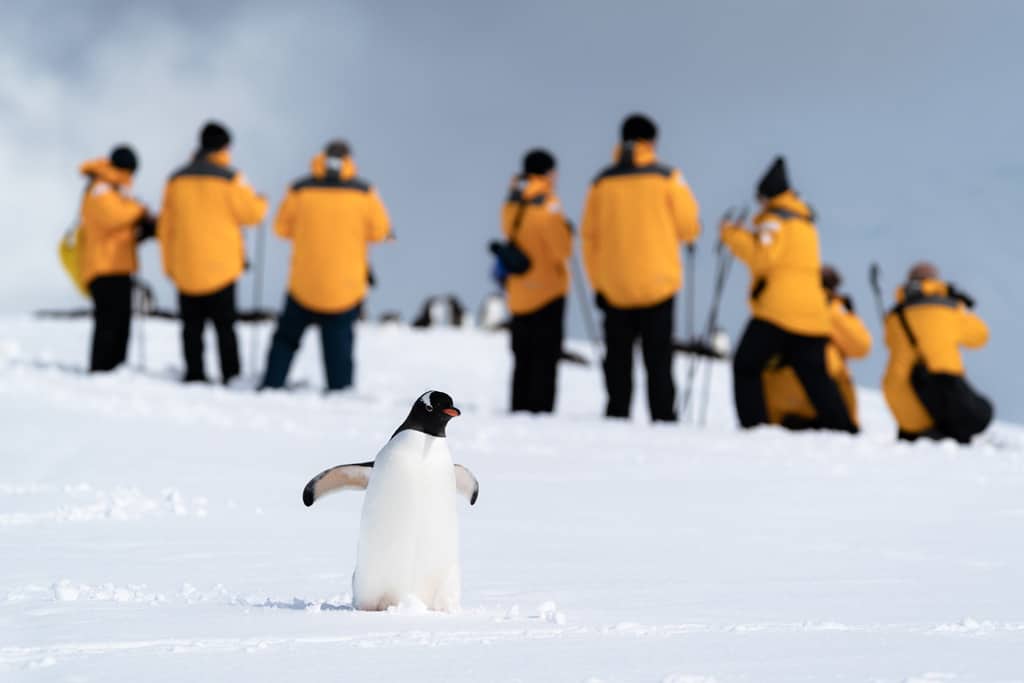Curious about Antarctica facts to learn more about the frozen continent? So are we, so we travelled down to Antarctica three times to learn everything we could about it! Here are 26 facts about Antarctica that blew us away.
Remote, wild, frigid and vast – Antarctica, also known as the White Continent, is one of the most sensational and unique ecosystems on earth.
Home to abundant wildlife, enormous glaciers and the majority of the world’s ice, it’s a destination that has been intriguing explorers and travellers for centuries.
We’ve personally travelled to Antarctica three times now working as photographers and tour leaders, and have many more photography tours planned in the coming years.
Every time we get down there we are blown away at just how interesting the ice covered continent is.
Besides loving everything that can be found down beneath the Antarctic circle, we also love a bit of trivia, which is why we put together this fun-filled guide to our favourite facts about Antarctica.
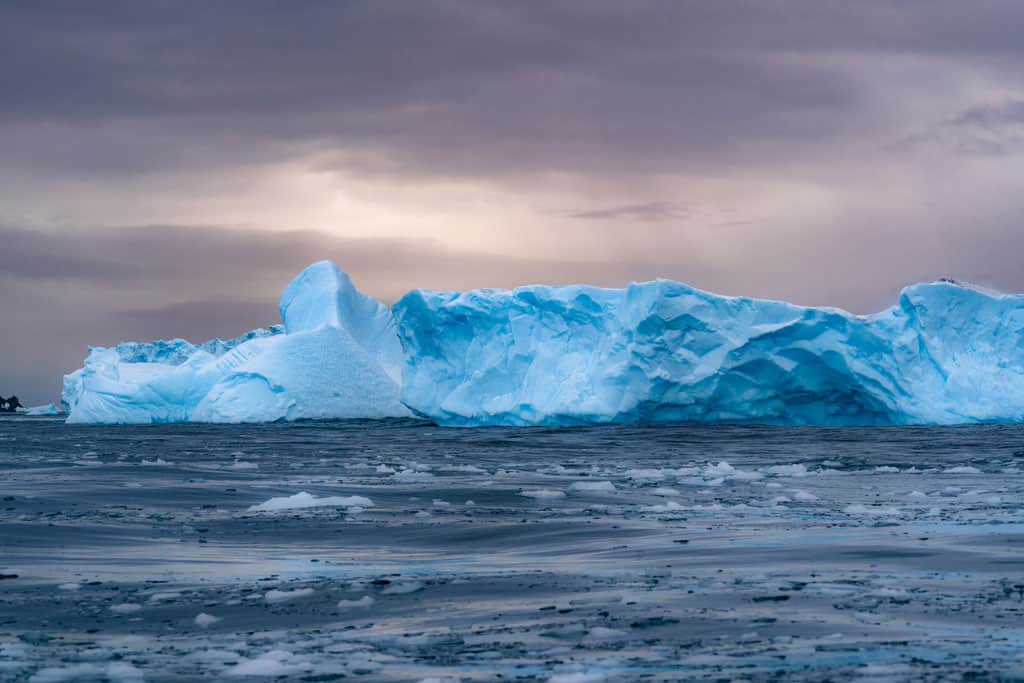
Table of Contents
- Antarctica Facts That Will Make You Want to Travel Here Immediately
- There are 7 Species of Penguins that Live in Antarctica
- There are 6 Different Species of Seals in Antarctica
- Antarctica is the Southernmost Continent on Earth
- Antarctica Covers an Area of 13.66 Million Square Kilometres
- The Highest Mountain in Antarctica is Mount Vinson
- Antarctica is Considered the Coldest Place on Earth
- Antarctica is a Desert
- The Antarctic Ice Sheet is Almost 5km Thick
- Antarctica Contains 70% of the World’s Fresh Water
- Roald Amundsen was the First Person to Reach the South Pole
- Antarctica is Home to Unique Wildlife
- There Are No Polar Bears in Antarctica
- Antarctica was First ‘Officially’ Discovered in 1820
- The Antarctic Treaty Was Signed in 1959
- There Are No Permanent Residents in Antarctica
- It’s a Hotbed of Scientific Research
- Antarctica is Crucial for Monitoring Climate Change
- Antarctica is Volcanic
- There’s a Waterfall that Runs Red
- Antarctica has the Aurora Australis, or Southern Lights
- There are More Than 200,000 Glaciers in Antarctica!
- There Are Nearly 400 Subglacial Lakes Here
- In Winter the Sun Never Rises
- In Summer the Sun Never Sets
- Antarctica Grows in Winter and Shrinks in Summer
- It is Possible to Visit Antarctica as a Tourist
Antarctica Facts That Will Make You Want to Travel Here Immediately
Without further ado, here are the most interesting Antarctica facts that will make you love the place as much as we do.
After our very successful tour to Antarctica this season, we are going to be running another exclusive adventure down to the Peninsula in 2025, this time crossing the Antarctic Circle! Check out the tour page if you’d like to learn more.
There are 7 Species of Penguins that Live in Antarctica
If you’re wondering “How many types of penguins live in Antarctica?”, wonder no more, because the answer is there are 7 species of penguins that live in the Antarctic!
- Gentoo penguins
- Adelie penguins
- Chinstrap penguins
- Emperor penguins
- King penguins
- Macaroni penguins
- Rockhopper penguins
Adelie penguins and Emperor penguins can only be found in Antarctica, while the others can also be seen in the sub-Antarctic islands such as South Georgia and the South Sandwich Islands.
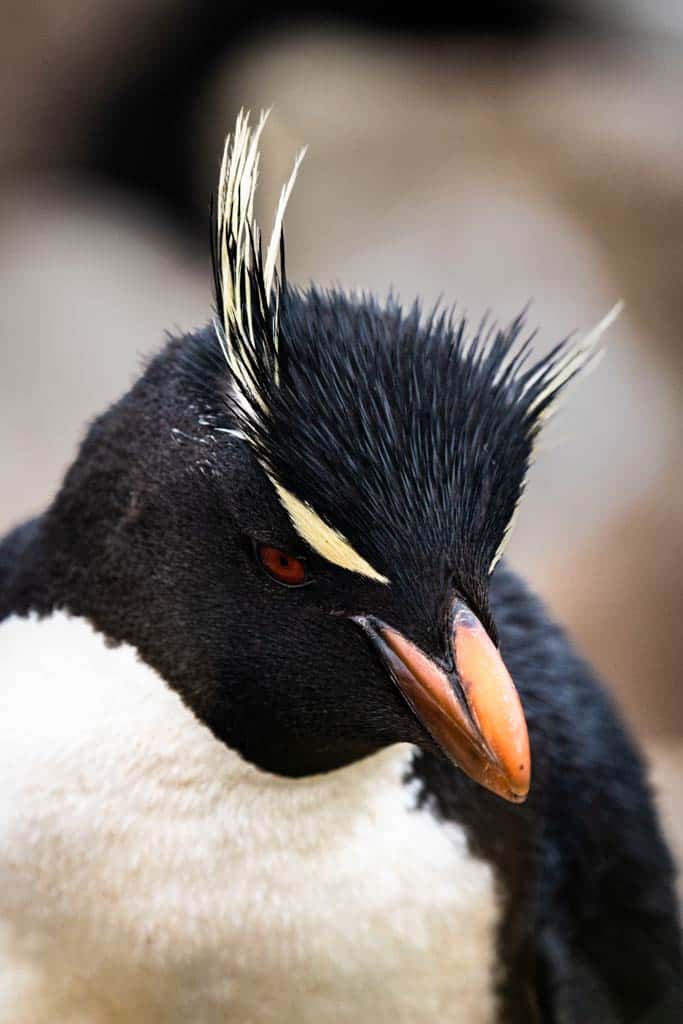
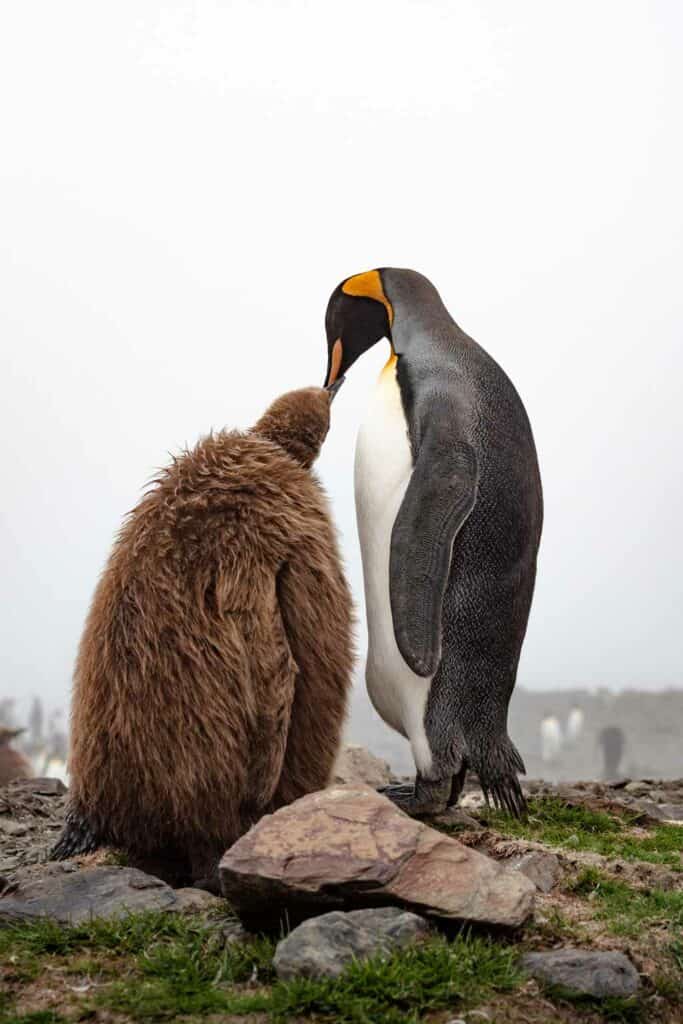
There are 6 Different Species of Seals in Antarctica
You’ll be thrilled to learn that there are 6 kinds of seals that live in the waters surrounding Antarctica. They are:
- Fur seals
- Ross seals
- Weddell seals
- Leopard seals
- Crabeater seals
- Elephant seals
Male elephant seals are the biggest, weighing up to 4 tonnes, and female fur seals are the smallest, weighing as little as 150kg fully grown.
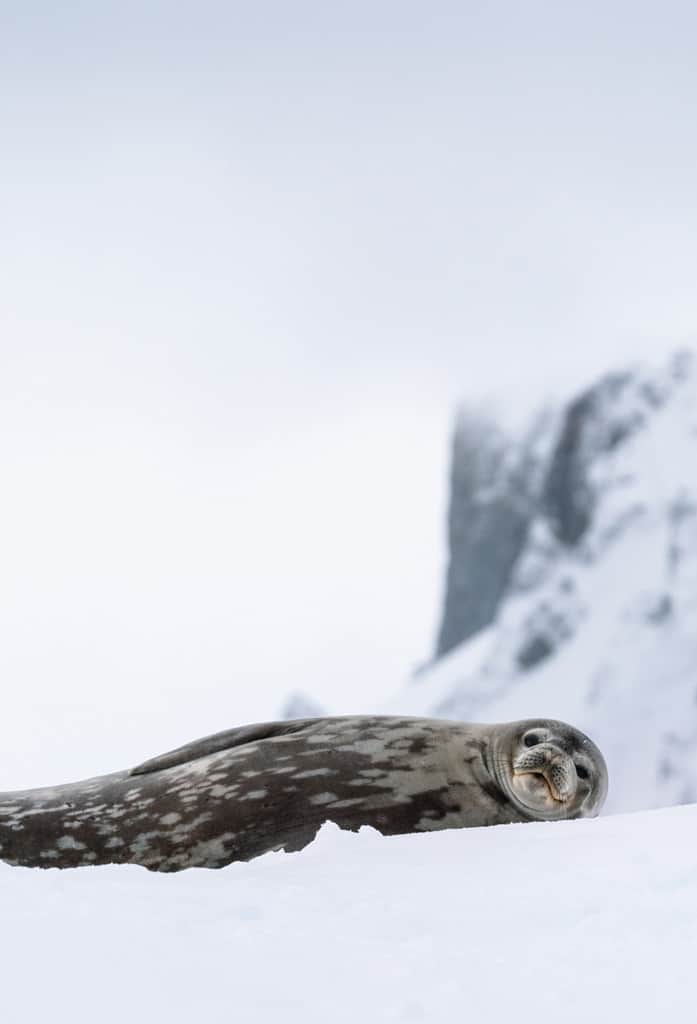
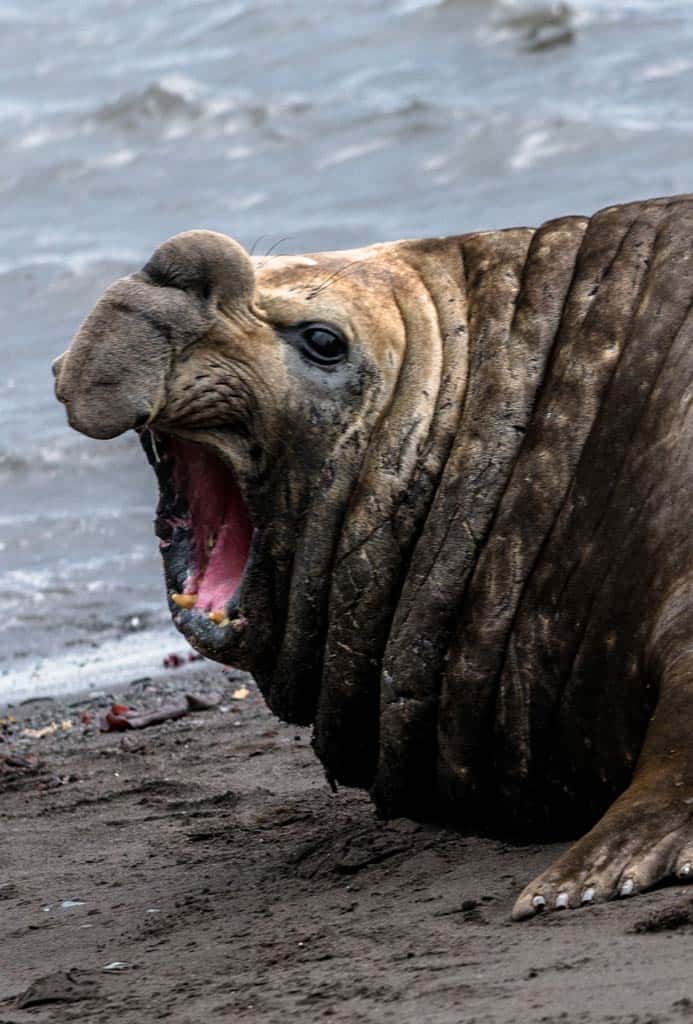
Antarctica is the Southernmost Continent on Earth
This one you may already know, but to set the record straight, Antarctica is the southernmost continent on the planet.
The huge landmass is located at the bottom of the globe, being an ice covered continent surrounded by the Southern Ocean.
Antarctica Covers an Area of 13.66 Million Square Kilometres
At 13.66 million km², or 5.27 million square miles, it is the fifth largest continent in terms of land area.
This makes it roughly the same size as the United States and Mexico combined.
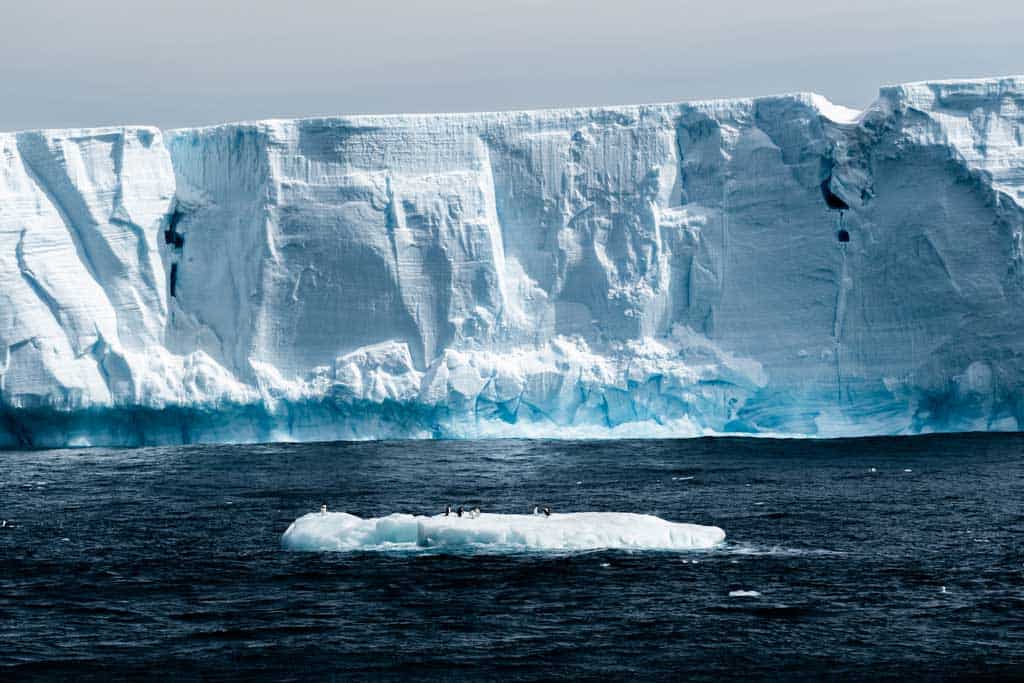
The Highest Mountain in Antarctica is Mount Vinson
Mount Vinson, or the Vinson Massif, is the highest mountain peak in Antarctica.
It stands 4,892m (16,050 feet) tall and is located south of the Antarctic Peninsula amongst one of the world’s biggest mountain ranges.
That makes it around half the height of Mount Everest.
Bonus fact – The second tallest mountain in Antarctica is Mount Tyree at 4,852m above sea level, and is just 13km northwest of Mount Vinson.
Read next: How To Get To Antarctica From South America
Antarctica is Considered the Coldest Place on Earth
Forget Siberia. The Antarctic is officially the coldest place on earth, with the lowest temperature ever recorded being -89.2°C (-128.6°F) at Vostok Station.
The yearly average temperature of Antarctica varies from 10°C on the coast to a freezing −60°C in the interior towards the South Pole.
Throw in the fact that it’s also the windiest continent on earth, and you start to understand just how desolate and wild it really is down there.
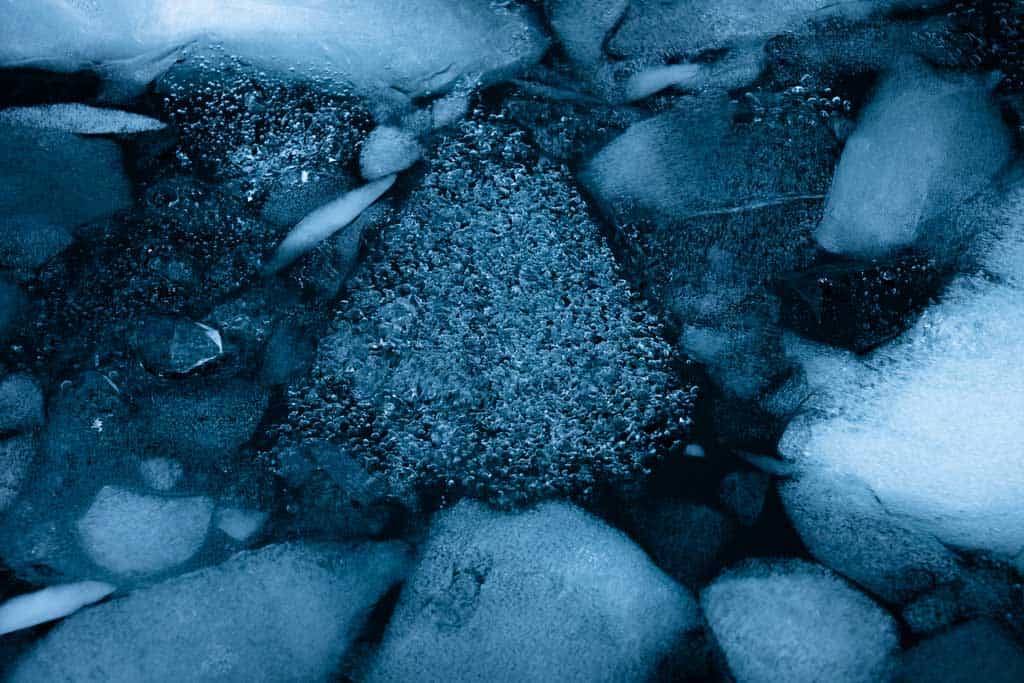
Antarctica is a Desert
Despite being covered in ice and snow, Antarctica is technically a desert due to the very little annual precipitation it receives.
On average the coast gets around 166mm of precipitation, and the further inland you get this number drops even lower.
The official metric that most climate scientists abide by is that to be classified a desert, an area of land should not get more than 250mm (or 10 inches) of precipitation in a normal year.
This fact about Antartica also makes it the driest continent in the world of all the seven continents.
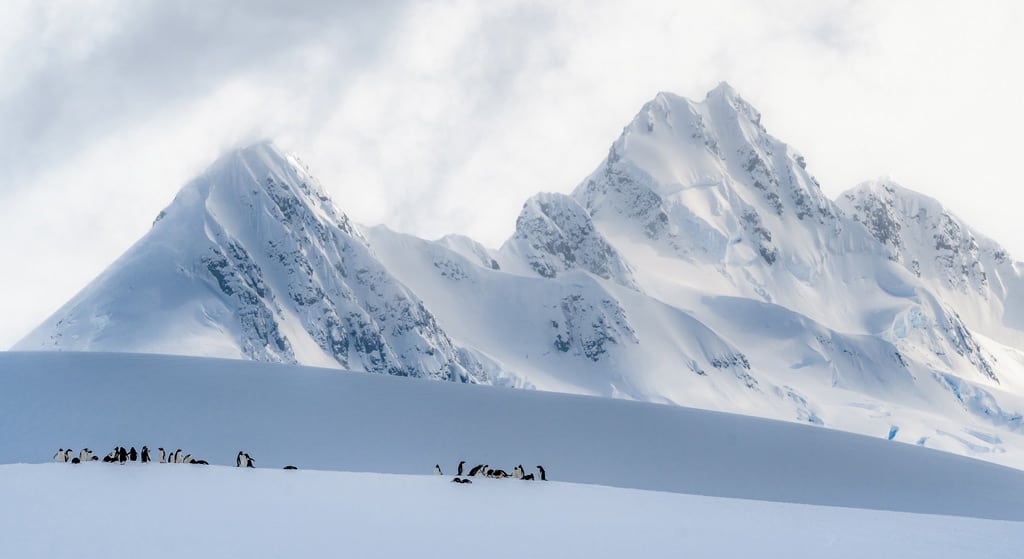
The Antarctic Ice Sheet is Almost 5km Thick
At it’s thickest, the inland ice sheet of Antarctica is 4,776m deep, and the average thickness is 2,160m across the entire continent.
That’s not at all though. That much volume of ice totals a mind-boggling 30 million km²!
READ MORE: Thinking about visiting Antarctica? Check out our comprehensive guide on what to do there!
Antarctica Contains 70% of the World’s Fresh Water
All of that ice and snow in sub zero temperatures contains roughly 70% of the planet’s fresh water.
If the entire ice shelf was to melt, experts believe the oceans would rise by 70m! All the more reason to protect the planet from climate change.
Roald Amundsen was the First Person to Reach the South Pole
In a hotly contested race to the South Pole, Roald Amundsen and his team from Norway became the first people to reach the southern tip of the earth on December 14th, 1911.
Amundsen just beat British explorer Robert Falcon Scott by just 34 days for this incredible achievement.
Antarctica is Home to Unique Wildlife
We’ve already talked about how many different species of penguins and seals live in Antarctica, but there’s so much more wildlife that calls Antarctica home!
There is an abundant diversity in marine life, from krill right up to the largest mammal on the planet, the blue whale, and everything in between.
A plethora of sea birds migrate down here in the summer months to feed and breed, including albatross, petrels and terns.
If you’re planning a trip to Antarctica then you’re no doubt going to end up with thousands of photos of wildlife, and everybody ends up with a different favourite animal.
Ours? Adelie penguins!
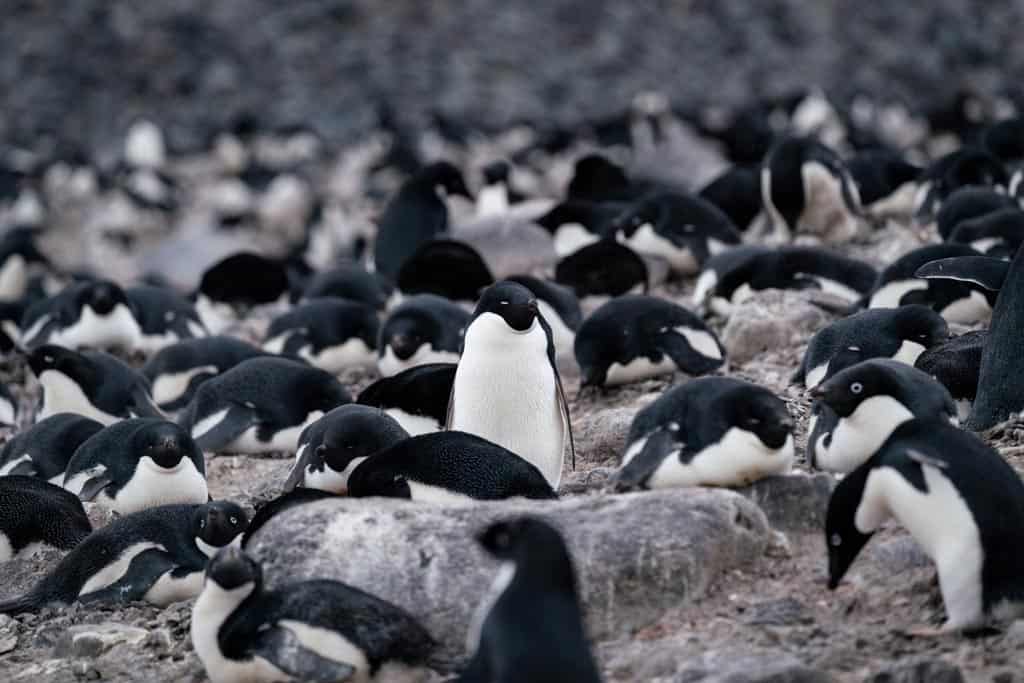
There Are No Polar Bears in Antarctica
You’re thinking of the Arctic. Sorry about that.
No walrus either.
Antarctica was First ‘Officially’ Discovered in 1820
According to confirmed reports, the first actual sighting of the Antarctic coast was on the 27th January 1820 by Russian explorer Fabian Gottlieb von Bellingshausen.
Before that Captain James Cook recorded crossing the Antarctic Circle in January 1773, but didn’t sight land.
There is evidence however that Maori people possibly reached Antarctica in the seventh century A.D, more than 1000 years before von Bellingshausen. Source.
The Antarctic Treaty Was Signed in 1959
On December 1, 1959, the Antarctic Treaty was signed in Washington D.C. by 12 countries that were conducting research and activities in Antarctica at the time.
The purpose of the Treaty is to promote peaceful scientific research in Antarctica, and to protect the seventh continent’s unique environment.
It also prohibits any military activity or establishing military bases there.
Today, there are 54 parties signed to the treaty.
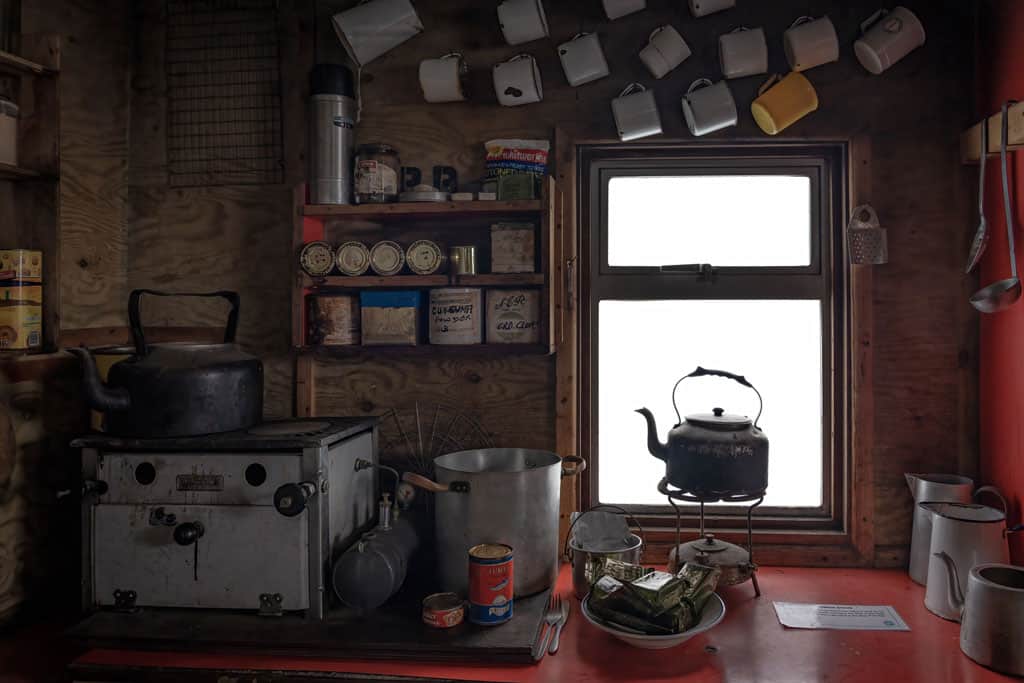
There Are No Permanent Residents in Antarctica
While there are a number of research stations operated by different nations throughout Antarctica, nobody lives permanently on the continent.
It’s a Hotbed of Scientific Research
Because so many countries have established research stations here, monitoring everything from the coldest temperature recorded to the movement of the ice shelves and even measuring the hole in the ozone layer, there’s a lot of things that scientists discovered right here from the seventh continent.
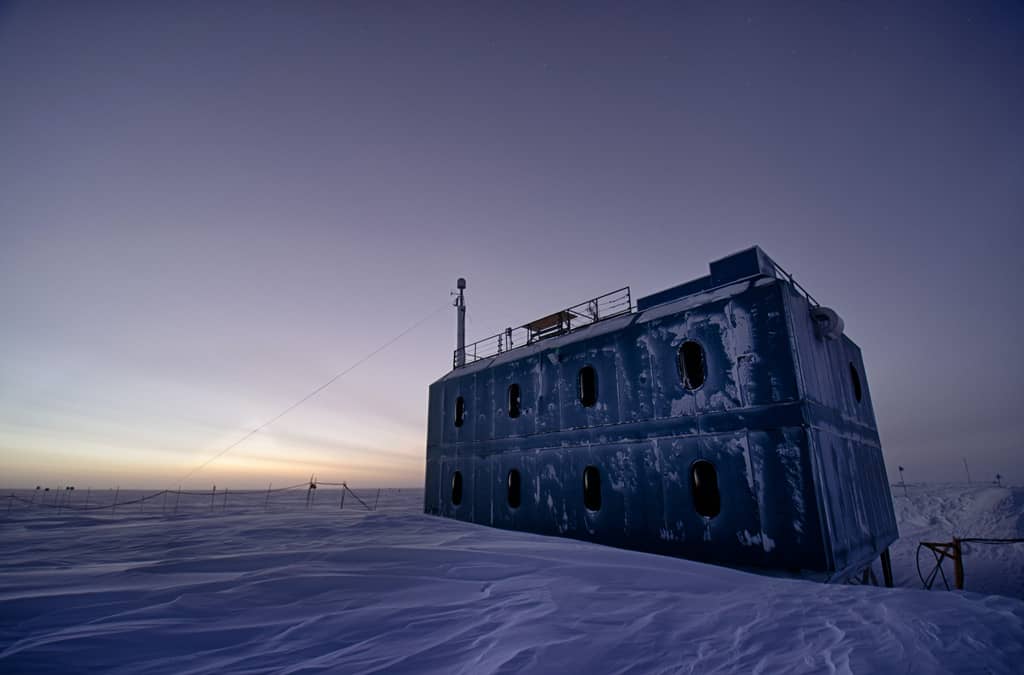
Antarctica is Crucial for Monitoring Climate Change
For scientists studying climate change and the effects of global warming, Antarctica provides a fascinating and scary insight into the world’s weather.
Picturing an ice free Antarctic and what that would look like for global sea levels is part of the issue currently being looked into by scientists.
EXCLUSIVE – We have partnered with the world’s top polar tour operator, Quark Expeditions, to offer readers of NOMADasaurus a very special deal on any trip to Antarctica or the Arctic! Contact us (hello@nomadasaurus.com) if you’d like to learn more.
Antarctica is Volcanic
There are a two active volcanoes in Antarctica which has helped form the geological foundations of the continent.
The largest active volcano is Mount Erebus (the second highest overall after Mount Sidley), and the second one is Deception Island below Cape Horn, the southernmost point South America.
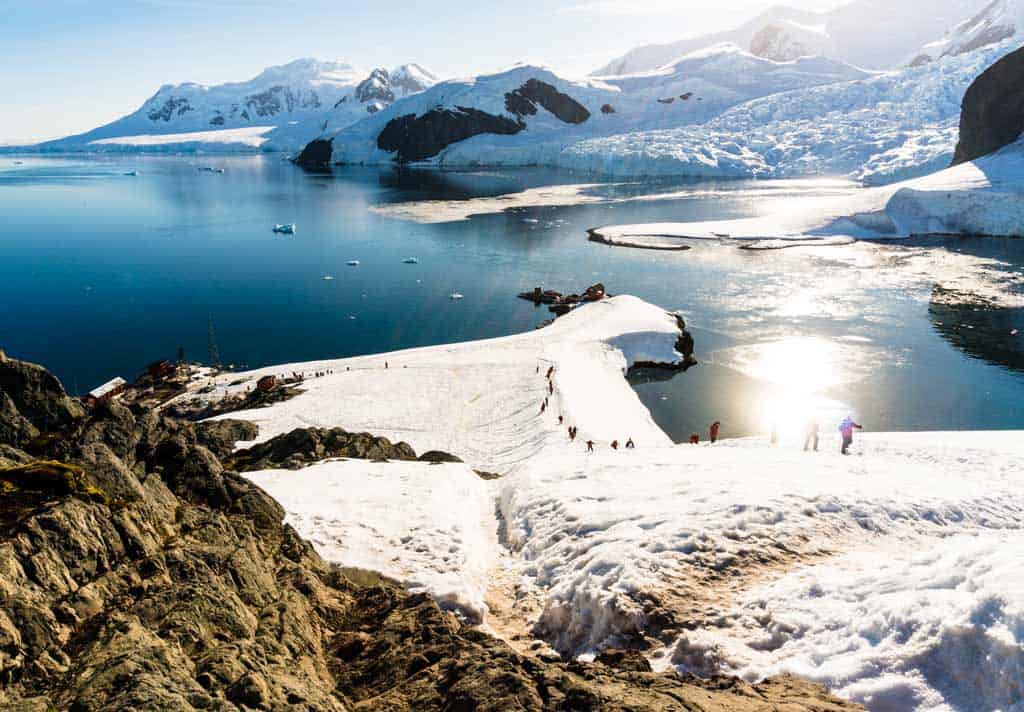
There’s a Waterfall that Runs Red
Taylor Glacier in McMurdo Dry Valleys is a 54km long glacier that has a very unique feature about it.
The lake that is part of the glacier is rich in iron deposits, and when parts of the ice melt they flow red, which has become known as ‘Blood Falls’.
Antarctica has the Aurora Australis, or Southern Lights
The Northern Hemisphere has the Northern Lights, or Aurora Borealis, but did you know that one of the coolest facts about Antarctica is that the southern hemisphere has their own similar phenomena?
The Aurora Australis, or Southern Lights, are the same magnetic light shows that can be seen up north, and best seen in the Antarctic winter (although summertime is possible too if far enough south).
There are More Than 200,000 Glaciers in Antarctica!
Being such a tremendous ice sheet means Antarctica is home to more than 200,000 glaciers.
From West Antarctica to East Antarctica and dropping into the Ross Ice Shelf, you can find glaciers just about everywhere in the continent.
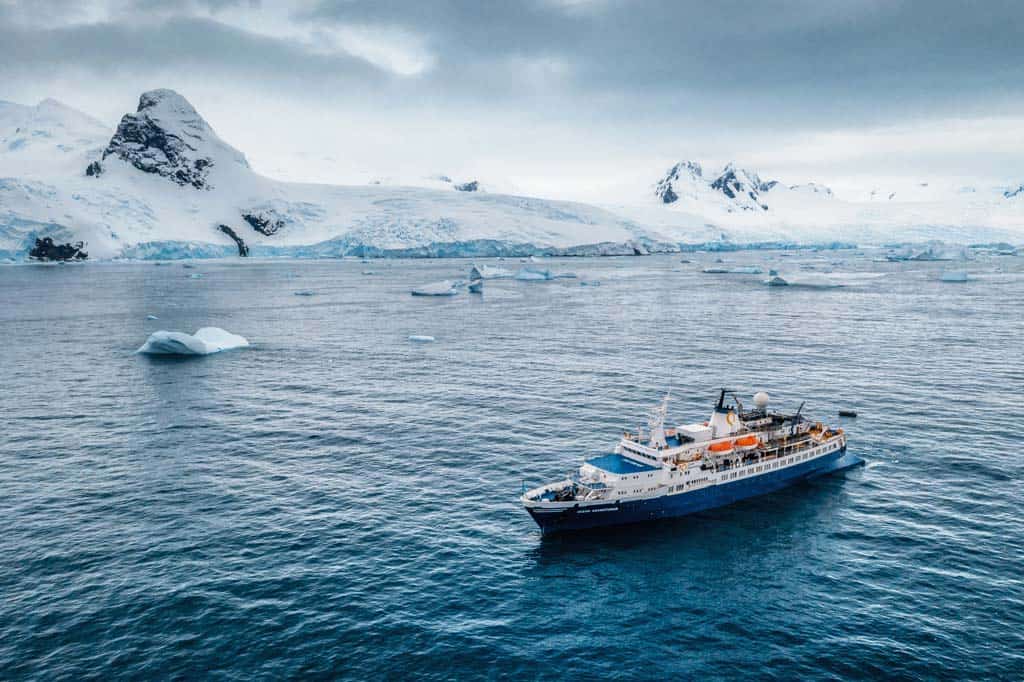
There Are Nearly 400 Subglacial Lakes Here
A subglacial lake is a lake that is found underneath a glacier, ice cap or ice sheet, and there are almost 400 of these on the continent.
Lake Vostok is the largest of them all, being subglacial lake high in the Pole of Cold near Russia’s Vostok station.
This deep lake is also where the coldest air temperature recording was made – pretty crazy for a polar desert!
In Winter the Sun Never Rises
One of the coolest Antarctica facts that people are curious about is that in winter the sun never actually rises, meaning there’s 24 hours of darkness.
This is due to the fact Antarctica is so far south and the world’s axis is tilted.
READ MORE: Learn about when the best time to visit Antarctica is with our guide!
In Summer the Sun Never Sets
In the summertime the opposite is true – the sun never sets beneath the Antarctic circle, providing constant daylight across this natural reserve.
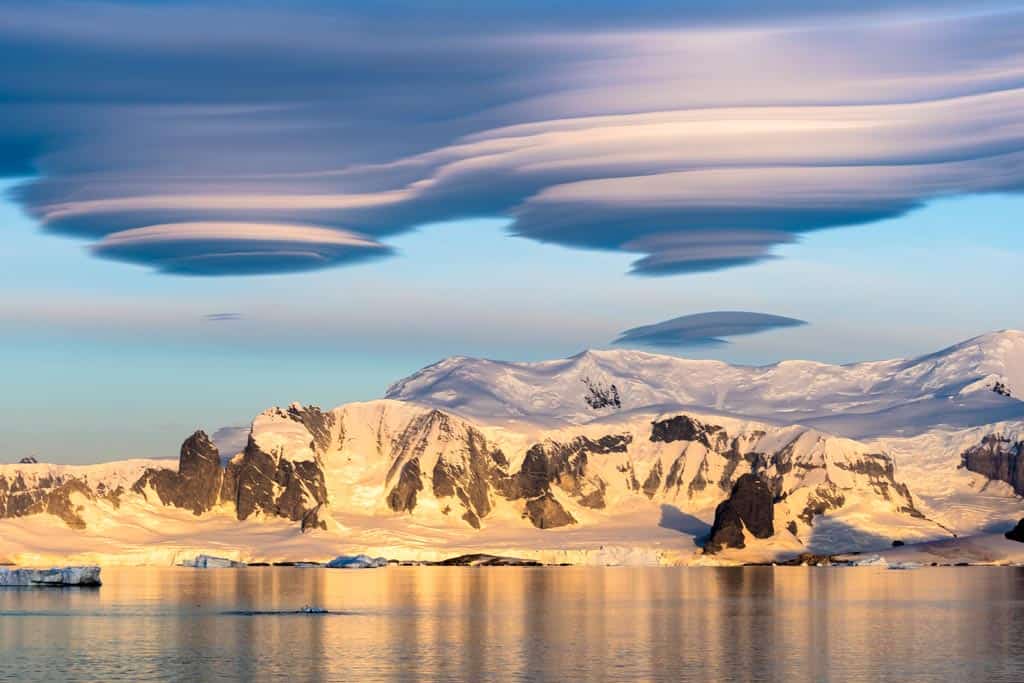
Antarctica Grows in Winter and Shrinks in Summer
When the temperatures drop the ocean and freshwater freezes creating sea ice, resulting in the ice thickness and surface of Antarctica getting bigger.
In the summer when the temperatures rise the Antarctic ice melts, making the continent smaller on its surface.
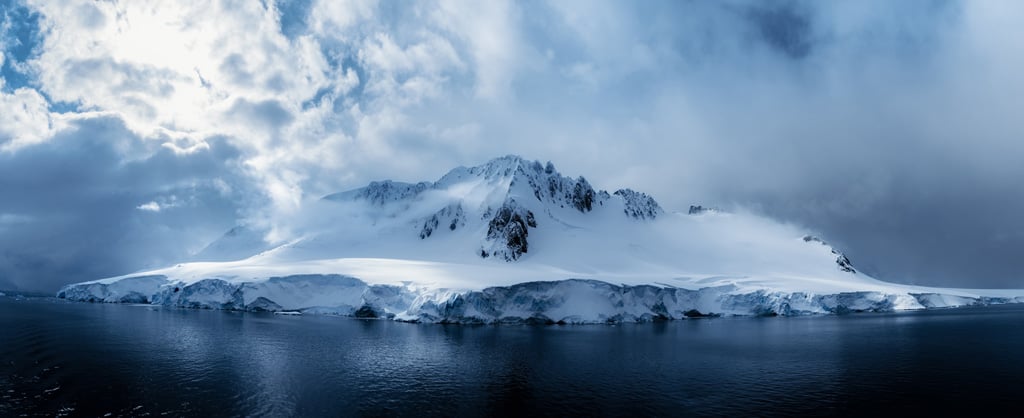
It is Possible to Visit Antarctica as a Tourist
Our final interesting fact about Antarctica is that you can actually visit this spectacular, icy land as a tourist!
Every year a number of specialised, licensed tour operators run expeditions to Antarctica, allowing visitors to see the windiest continent for themselves.
Most of the trips leave from Ushuaia at the bottom of South America, cross the Drake Passage and then return.
But it’s also possible to fly to Antarctica from Punta Arenas in Chile, or travel via the Falkland Islands and South Georgia too.
Only one or two trips a year leave from New Zealand or Australia, and these are usually much longer journeys and far more expensive, but they do visit a part of the continent that very few people ever see.
Antarctica remains one of the most pristine, wild and beautiful places in the world, and with all these best facts about Antarctica we hope you’re more interested than ever to try and get down there one day.
Keen to visit yourself? Get in touch with us to learn more about our very exclusive Antarctica tours!
